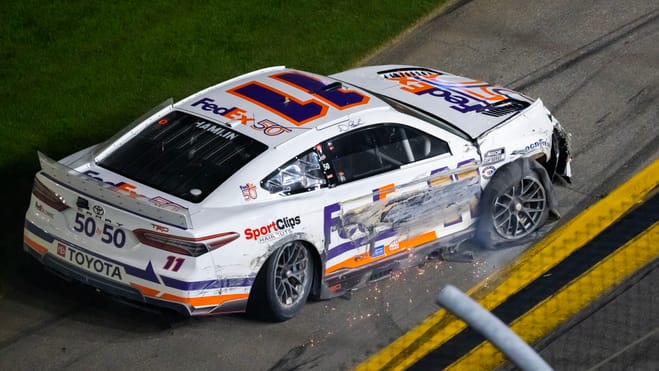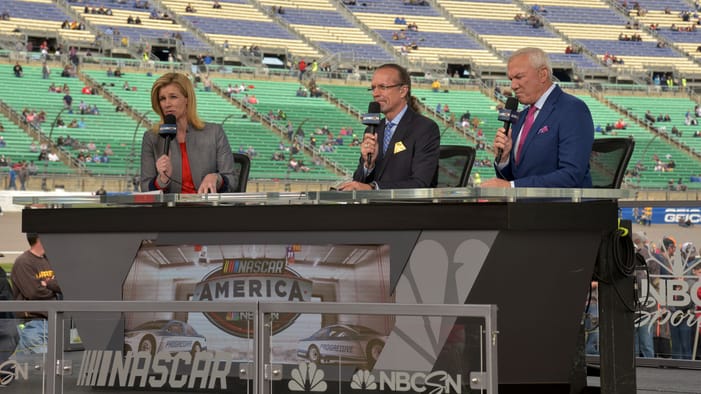NASCAR’s second-year Cup Series car, christened the NextGen, is a very expensive machine.
“We’re racing Lambos,” said Denny Hamlin on Tuesday during an episode of his Actions Detrimental podcast.
For the first time in two years, a Cup Series team owner has detailed the exact cost of racing at the highest level, and it’s currently an astronomical figure. It’s not supposed to be, and in time, that might change, but the cost to compete remains a work in progress.
For one, this is the first NASCAR spec car, meaning that every major component is the same for every participating team.
There are exceptions, of course.
“There are still fasteners, brackets,” Hamlin said on the podcast. “If you buy the NextGen car, there’s still hundreds of parts and pieces you either need to buy or manufacture. That actually puts the car together.”
“The NextGen comes with a booklet of how to put it together. It comes with an instruction manual, this is hilarious. Kyle Busch called it the Walmart car or something. No, no no, this is IKEA. Things like seat brackets, dashes, there is no mandate for that stuff. There’s a lot of other stuff that I don’t even know about.”
Prior to the 2022 season, teams would build their own cars to a prescribed rule book, with research and development costs taking up a large part of a competition budget but moving to a completely new state-of-the-art platform had also created a tremendous amount of overhead.
How much overhead?
“When we initially got the budget for the Next Gen car, this was 2-2.5 years ago, the cost was coming in below what we were expecting it to be (and) it was around $225,000,” Hamlin said. “All in, right now, this is a rough estimate. With all the other stuff you have to purchase to actually make it roll, $350,000.”
Every individual car is $350,000 right now, and each entry is allowed to have a maximum of seven cars in the shop at one time. So, for a two-car team like the 23XI Racing organization that Hamlin co-owns with Michael Jordan, that’s almost five million dollars in the actual cars themselves.
“We’re racing Lambos out there,” Hamlin said. “At the end of the race, I see a big crash. I roll back around like, ‘Please don’t be any of my cars.’ (because) it’s such a big cost.”
Related: Kyle Larson’s Indy 500 journey begins with rookie orientation test
More expensive crashes

The durability of these cars has changed for better and worse over the past two years, depending on how you look at it.
NextGen’s original version was built super stiff, with the front and rear bumpers not caving to impact at all, meaning the drivers absorbed a dangerous amount of that energy. Due to that dynamic, 2004 champion Kurt Busch was forced into premature retirement after crashing during qualifying last summer at Pocono.
Several similar crashes forced NASCAR to redesign both ends of the car to where it absorbs more energy, making drivers safer but resulting in more crash damage, thus making the cars more expensive than intended.
“Our crash budget has gone up tremendously because we had to make safety changes,” Hamlin said. “Now, when you hit the wall, you see the cars crushing. Well, it’s crushing expensive shit. It’s worth it for us. You want driver safety. Whatever that cost, we have to do that.”
“When you have big rear-end crashes, you probably will damage the most expensive part of the car, which is the trans-axle. Which is $50,000. The cars have gone up. The crash budget has gone up. Our budget as team owners has gone up. We’ve only been running the Next Gen a couple years, it has gone up, a lot since the beginning.”
“Let the teams build it.”

Due to the spec nature of the NextGen, the primary components are built by 26 single source manufacturers ranging from the bodies, chassis, gearbox, brakes, etc.
NASCAR fielded bids from the motorsports and engineering industries and selected the suppliers who would design and sell the parts.
“Some of the issue we have is we have single-source suppliers,” Hamlin said. “They can somewhat dictate what the price is. There’s a certain cost of the Next Gen car that they can automatically raise and not even have to get the OK. Labor, inflation, they can raise the price and not even have to say anything.”
“One manufacturer makes a bid for the control arms, they win the bid. So we all have to purchase from company A. That price can float, and it never floats down.”
Hamlin’s solution is to have one team each build specific parts for all their peers.
“Look at Hendrick Motorsports, Joe Gibbs Racing, Stewart-Haas, they could build this NextGen car,” Hamlin said. “We could build the NextGen car, in-house.”
“This is just my opinion. You could let Joe Gibbs Racing build the clips. Hendrick Motorsports builds all the deck-lids, hoods. NASCAR techs these cars so vigorously, it’s not like they could give themselves a better deck-lid.”
“I mean, they could. That’s the only negative part.”
Hamlin says he would be willing to accept this risk as a competitor and also believes that teams would actually build these parts better than the single-source suppliers. There have been countless incidents over the past two years where teams would buy a part from a supplier, and it actually didn’t fit the car.
They would either have to take it to NASCAR or risk modifying it themselves, sometimes resulting in a penalty from the sanctioning body.
“The cost of the car is so high, I’d be willing to take that risk,” Hamlin said. “And, I believe that the teams quality control would be better than any of the other manufacturers.”
“It could save us a tremendous amount of money. The teams could build this Next Gen car much much cheaper than what it costs us currently to purchase it from someone else. We could probably build this car for half of what we’re paying for it right now. You have to make sure that the builder does not get the best of everything.”
Related: 2024 NASCAR schedule takeaways
Another solution?

Or, Hamlin suggests, NASCAR could give teams a larger part of the television pie after it completes its next broadcast rights agreement over the next year.
Teams currently receive 25 percent of the TV money. Tracks receive 65 percent of that revenue, and NASCAR itself receives 10 percent. NASCAR owns half the tracks on the schedule alongside Speedway Motorsports and independent tracks Indianapolis Motor Speedway and World Wide Technology Raceway.
“The need for a new business model is so important for us,” Hamlin said. “This NextGen car is not saving us the money that we thought that it would back when the team owners voted on a NextGen car.
“What we want as team owners is for our costs to compete to be covered by the league. There’s not a league where the cost to compete is not covered, except for in NASCAR.”
Matt Weaver is a Motorsports Insider for Sportsnaut. Follow him on Twitter.